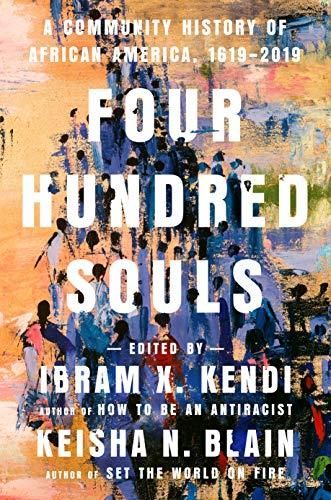Professors and authors Ibram X. Kendi and Keisha N. Blain offer a compelling, sweeping new perspective on the history of Black Americans, both enslaved and free.

Comprehensive Black History
CBS News racial justice correspondent Ibram X. Kendi is a chaired professor at Boston University and author of the best-selling How to Be an Antiracist. Professor Keisha N. Blain is an award-winning historian and author of Set the World on Fire. The two authors compiled this anthology of the voices of 80 writers and poets to deliver a gripping narrative history.
O: The Oprah Magazine said the book “weaves a tapestry of unspeakable suffering and unexpected transcendence.” The Washington Post called it “a vital addition to the curriculum on race in America.”
1619
Kendi details the backstory of a haunting protest song – Billie Holiday’s rendition of “Strange Fruit” – about lynchings in the South as a conduit for unearthing the roots of slavery dating back to the 1600s.
In early 1619, European merchants seized Black people from West Africa. In August, 20 to 30 West Africans disembarked from the cargo ship White Lion in Jamestown, Virginia.
The Adams and Eves of Black America did not arrive here in search of freedom or a better life. They had been captured and stolen, forced onto a ship, shackled, writhing in filth as they suffered and starved.Ibram X. Kendi and Keisha N. Blain
The authors reveal that scholars see August 20, 1619 as the start date of African-American history.
British Royal Family
The British royal family has a shocking history of trafficking in slavery. The Royal African Company (RAC) of England emerged as the premier institutional participant in transatlantic human traffickings. RAC enriched King Charles II and his brother, King James II.
The Royal African Company carried more Africans to the Caribbean and the Americas than any other trading company.During a 10-year period ending in 1683, England’s share of the African human trafficking market rose from 33% to 75%.
1705 Slave Codes
Virginia lawmakers codified slavery in 1705, clarifying that white men could invest in British colonies and own Black people. Kendi and Blain point out that by 1700, Virginia’s population included 6,380 enslaved Blacks – up from 3,000 in 1680.
Slave Revolt
By the mid-18th century, South Carolina had a Black population of 39,100 and a white population of 20,000. The state’s Stono Rebellion began on September 9, 1739, when Black participants gathered near the Stono River, about 20 miles from Charleston.
There’s nothing to suggest that the rebels at Stono were political visionaries, that they aspired to overthrow the system of enslavement and plunder…They most likely just wanted to escape. Ibram X. Kendi and Keisha N. Blain
The enslaved people hoped to flee to Spanish-controlled Florida, which offered safe haven. Some 25 whites died before a white militia killed the rebels. In the aftermath, the authors show, colony leaders passed the Negro Act of 1740, which limited enslaved people from assembling or seeking education.
Fugitive Slave Act
Kendi and Blain clarify that the voting rights act of 1788 applied exclusively to white male property owners. The nation’s first president, George Washington owned enslaved people and signed the 1793 Fugitive Slave Act into law. That law made helping enslaved people flee into a federal crime and provided bounties for captured fugitives.
Dred Scott
Kendi and Blain present the crucial story of Dred Scott, who sued slaveholder John Sandford for the freedom of his family in 1857. The US Supreme Court ruled that national citizenship did not apply to anyone of African descent, whether born free or enslaved. The ruling, Kendi and Blain conclude, deprived Dred Scott – and all then-enslaved Americans – of any claim to the rights of free citizens.
Black Union Soldiers
Kendi and Blain celebrate the historic New Year’s Day of 1863, when President Abraham Lincoln signed the Emancipation Proclamation, freeing the enslaved – though, the authors point out, only in secessionist states – and enabling formerly enslaved men to join the US Army. The authors report, astonishingly, that nearly 200,000 Black soldiers fought for the Union in 39 major Civil War battles.
The 13th Amendment to the US Constitution ended slavery in 1865, and the 1870 ratification of the 15th Amendment called for citizenship and equal legal protections for the formerly enslaved. White supremacists reacted with violence, repression and race riots. Although Black citizens achieved economic and political gains, racists fought against progress with lynchings and reprisals.
Black Lives Matter
Kendi and Blain trace the modern Black Lives Matter movement to the civil rights leaders and activists of the 1960s, including Malcolm X and Martin Luther King, Jr.
Contemporary social justice movements, ranging from Black Lives Matter (BLM) to efforts to end mass incarceration, stand on the shoulders of Black Power activists who led a sprawling, intersectional, multigenerational human rights movement.Ibram X. Kendi and Keisha N. Blain
In 2013, a Florida jury acquitted white vigilante George Zimmerman of the murder of Trayvon Martin, a Black teenager. In the wake of Martin’s death, Alicia Garza, Opal Tometi and Patrisse Cullors launched the Black Lives Matter movement.
Rich History
Kendi and Blain make it clear that, sadly, racism is a fundamental aspect of US history and culture. If you counter “Black Lives Matter” with “All Lives Matter” – which is true but is hardly the point of being alert to the degradations of racism – this is probably not a book for you. However, the authors aren’t just preaching to the choir. They offer a rich, detailed Black-centric history vested in American voices that provides a worthwhile text for students and an illuminating overview for adults.
Kendi and Blain are best-selling authors, scholars and admired historians; they have no need to be inflammatory or polemical and, indeed, they never are. They offer a lot to learn, including many heretofore untold tales which combine to present a new perspective on American history and culture and the role of Black Americans in both.
Ibram X. Kendi’s other books include How to Be an Antiracist, How to Raise an Antiracist, Stamped and The Black Campus Movement. Keisha N. Blain’s works include Until I Am Free and her contributions to the anthologies To Turn the Whole World Over and New Perspectives on the Black Intellectual Tradition.






